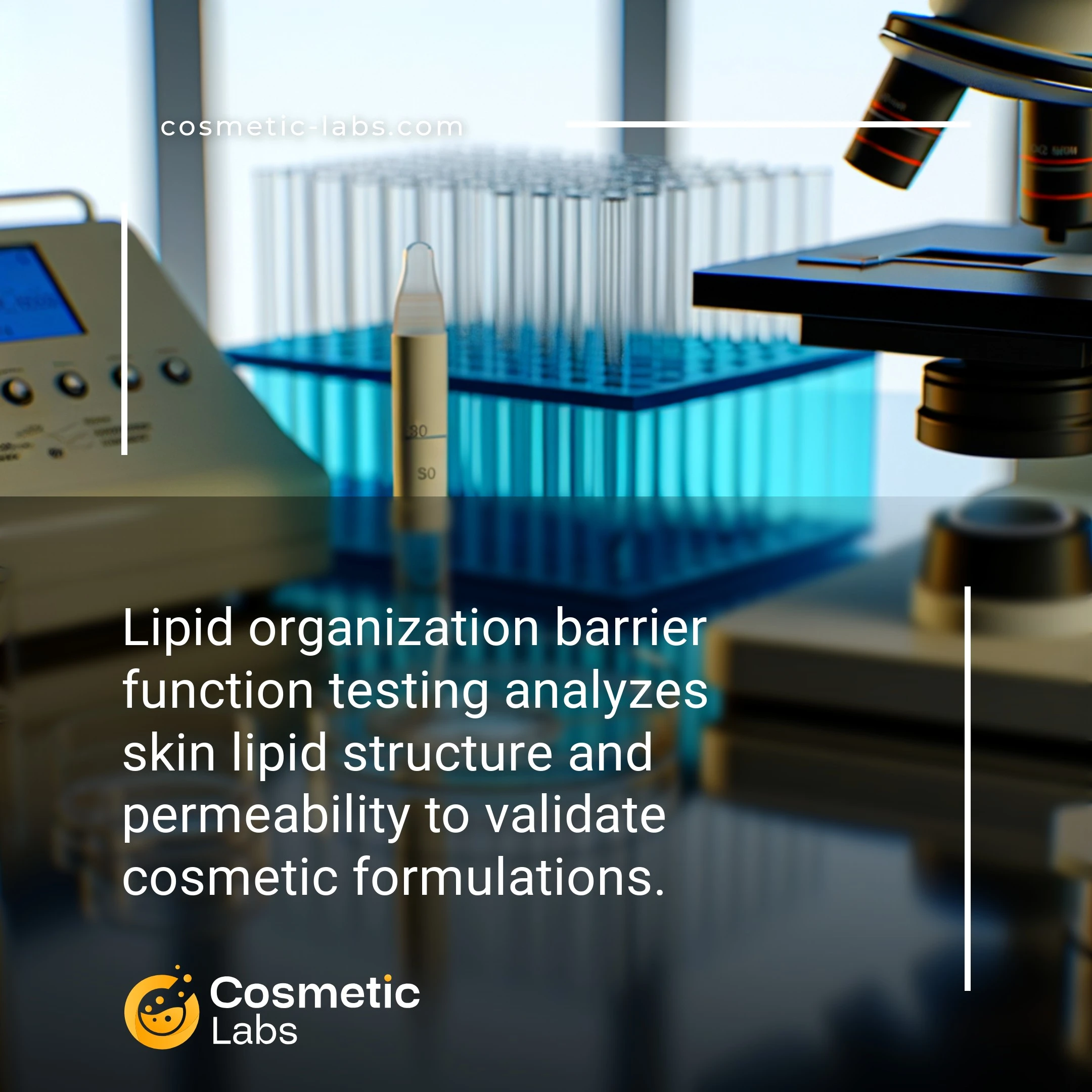Lipid Barrier Function Testing Services for Cosmetic Labs

What is Lipid organization?
Lipid organization barrier function testing is a specialized analysis that measures how well cosmetic ingredients arrange within the skin’s natural lipid layers to strengthen protective barriers. Labs use advanced techniques like X-ray diffraction and electron microscopy to evaluate bilayer structure formation and intercellular lipid alignment in stratum corneum models. This testing reveals whether your formulation actually improves skin barrier integrity or disrupts the delicate lipid matrix—data that’s often missing from basic permeation studies but determines real-world product performance.
Why do you need this service?
Cosmetic labs use lipid bilayer organization analysis to validate moisturizer formulations and assess how active ingredients affect skin barrier integrity. Brand owners rely on these tests to demonstrate product efficacy claims, while formulators use the data to optimize ceramide ratios and fatty acid compositions in barrier repair products. The testing reveals quantifiable improvements in transepidermal water loss and lipid lamellar structure, providing regulatory-grade evidence for marketing claims about barrier restoration and hydration benefits.
Who provides Lipid organization services?
All cosmetic labs providing Lipid organization services
There is no company providing these services at the moment.
Lipid Bilayer Testing for Skin Barrier Function
Cosmetic labs measure how lipid organization affects your product’s ability to strengthen or protect the skin barrier. These tests reveal whether your formulations can repair damaged lipid structures or maintain healthy barrier function through targeted lipid analysis.
Stratum Corneum Lipid Analysis
Labs extract and analyze the three main barrier lipids: ceramides, cholesterol, and free fatty acids. They measure lipid ratios and organization patterns using techniques like X-ray diffraction and differential scanning calorimetry. This data shows how your ingredients interact with natural skin lipids.
Key measurements include:
- Ceramide subclass distribution (NS, NP, AS, AP)
- Cholesterol sulfate levels
- Fatty acid chain length variations
- Lamellar phase transitions
Membrane Fluidity and Permeability Testing
Testing facilities use lipid bilayer models to simulate how your products affect membrane structure. They create artificial skin barriers with controlled lipid compositions, then measure changes in fluidity and permeability after product application. Franz cell diffusion studies track how active ingredients penetrate through these lipid layers.
Labs also run thermal analysis to detect phase separations that could compromise barrier integrity. These tests help predict whether your formulation will enhance or disrupt the skin’s natural lipid organization.
Contact labs on our platform to discuss lipid barrier testing protocols that match your product development timeline and regulatory requirements.
Applications of Lipid Organization Testing for Barrier Function Assessment
Cosmetic labs use lipid organization testing for barrier function assessment to validate claims about skin protection, moisture retention, and repair mechanisms in beauty products.
Anti-Aging Product Development
Labs analyze ceramide organization and intercellular lipid structure to prove anti-aging claims. Testing protocols measure stratum corneum lipid bilayer integrity using techniques like X-ray diffraction and electron microscopy. Results demonstrate how formulations restore lipid barrier organization that degrades with age.
Product developers receive data showing lipid lamellar structure improvements within 14-28 days of application. These measurements support marketing claims about barrier repair and moisture retention efficacy.
Sensitive Skin Formulation Validation
Testing services evaluate how products affect lipid membrane fluidity and permeability in compromised barrier conditions. Labs use Franz cell diffusion studies and impedance measurements to assess barrier restoration capabilities. This data proves formulations won’t disrupt already weakened skin barriers.
Brands receive documentation showing reduced transepidermal water loss and improved barrier recovery rates. These results validate gentle formulation approaches for sensitive skin product lines.
| Testing Method | Measurement Focus | Typical Timeline | Key Output |
|---|---|---|---|
| X-ray Diffraction | Lipid crystalline structure | 2-3 weeks | Lamellar spacing data |
| Impedance Spectroscopy | Barrier electrical resistance | 1-2 weeks | Permeability coefficients |
| Franz Cell Studies | Transepidermal water loss | 3-4 weeks | Barrier function curves |
| Electron Microscopy | Lipid bilayer morphology | 2-3 weeks | Structural imaging |
Contact specialized cosmetic labs on our platform to access lipid organization testing services that validate your barrier function claims with precise scientific data.
